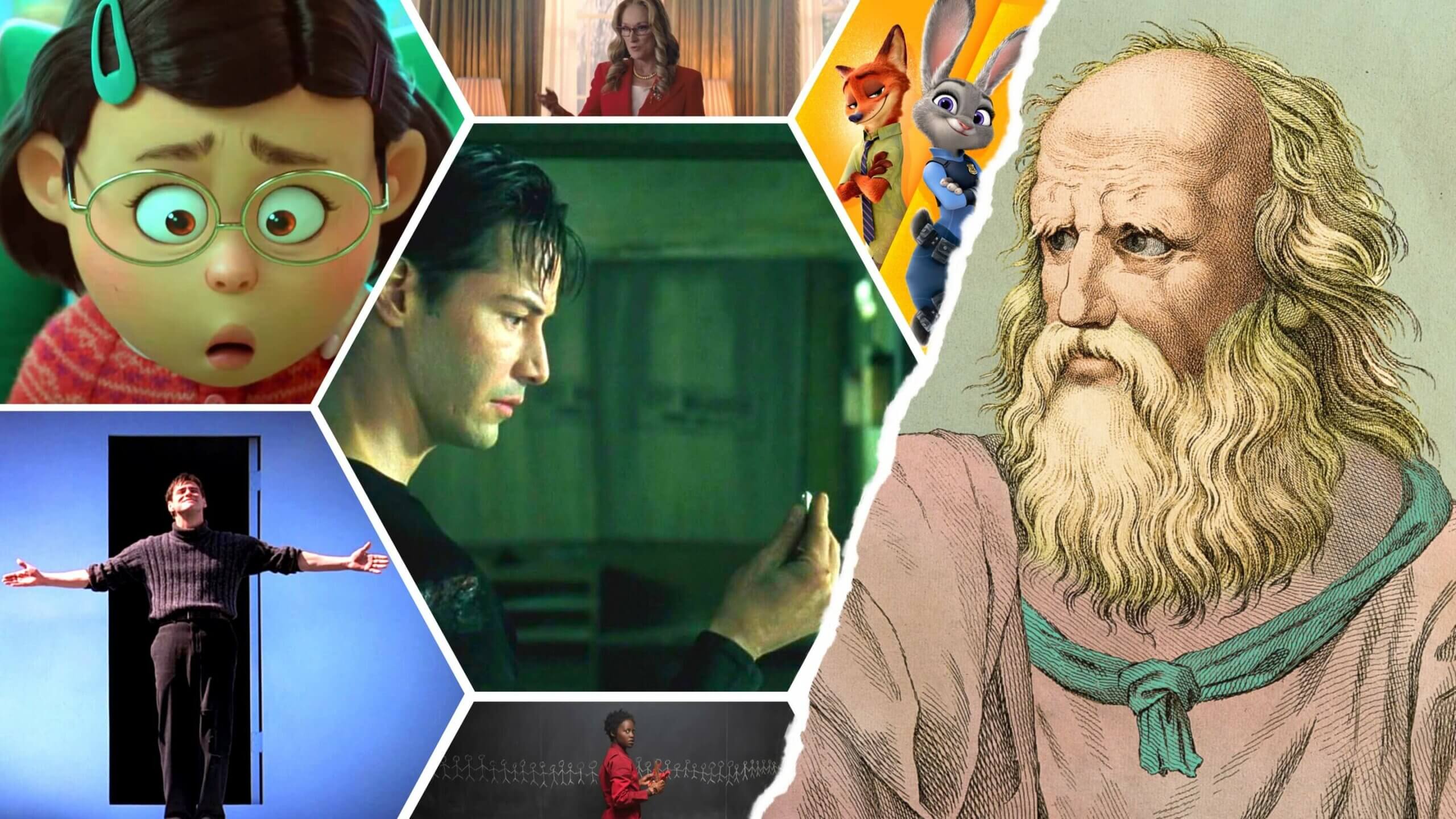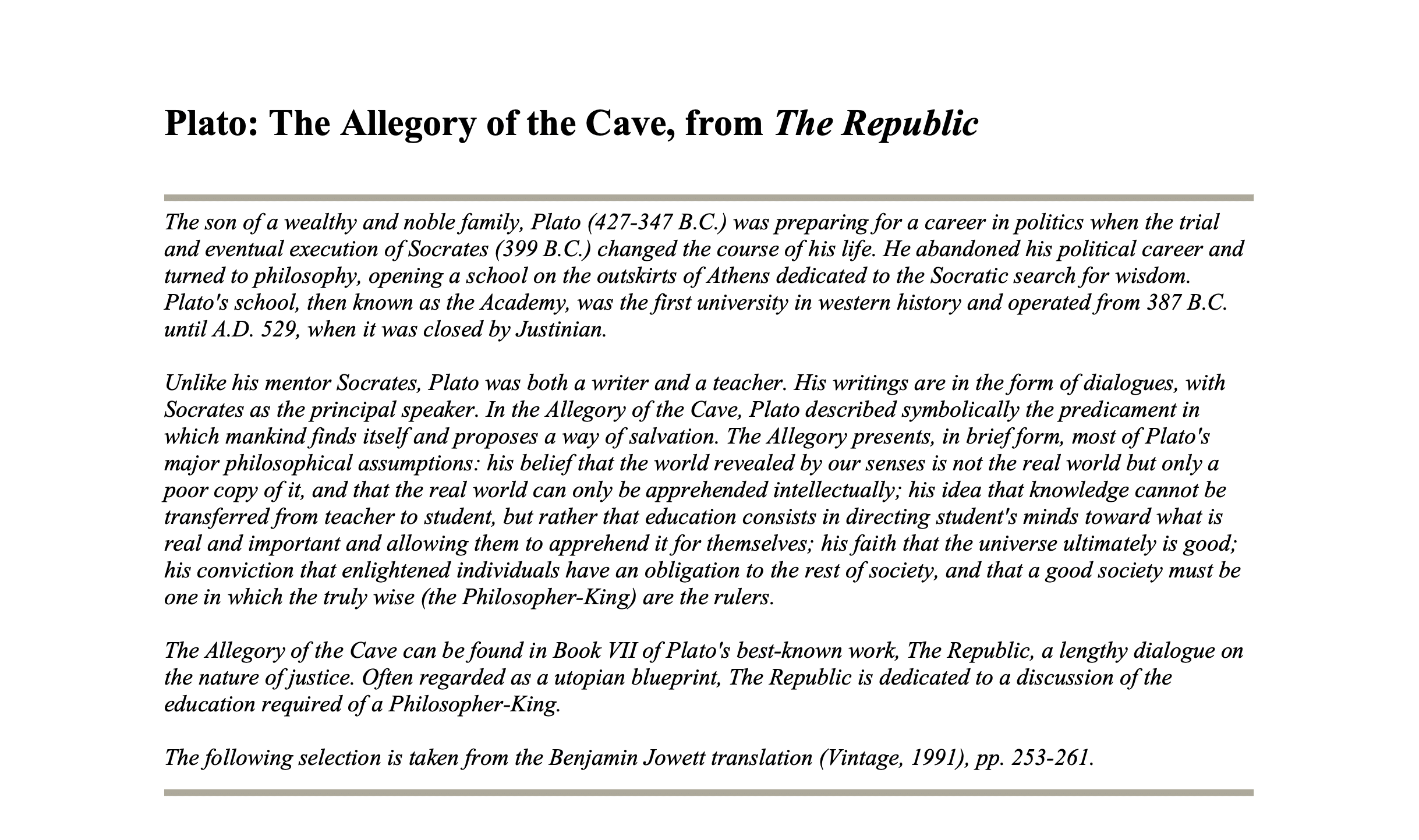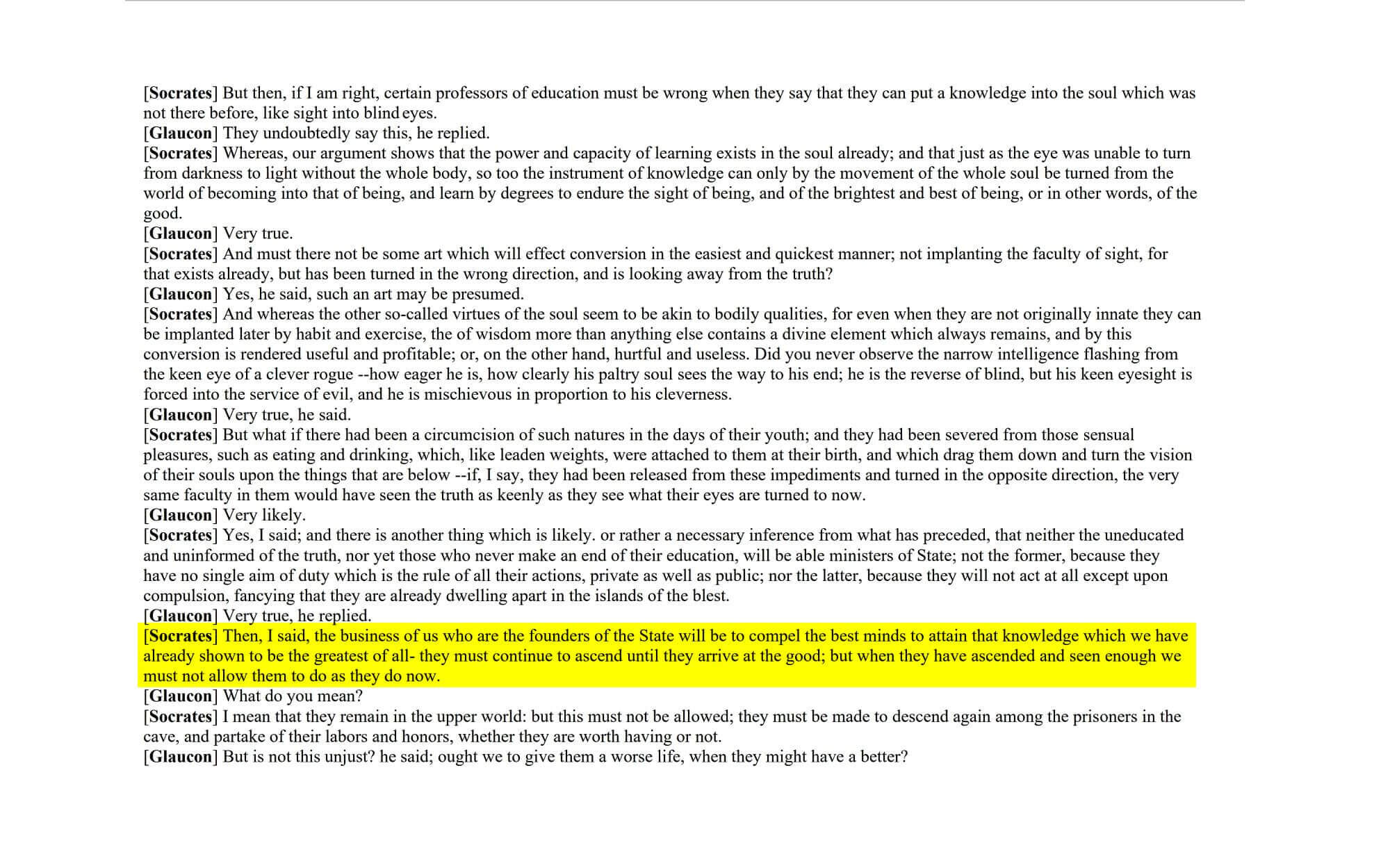Plato’s “Allegory of the Cave” is one of the most well-known philosophical concepts in history. As such, it only makes sense that numerous filmmakers would try to incorporate this philosophy into their movies. But what exactly is it? And why does it work so well in the context of filmmaking? We’ll look at this concept as well as several films that have incorporated it excellently. It’s time to find the sun.
Plato's Cave Explained
Entering Plato's allegorical cave
Virtually all philosophy descends from Plato. And this particular piece of philosophy routinely comes up in discussions of how humans perceive reality and whether there is any higher truth to existence.
This is a concept pondered and considered for thousands of years and we're still nowhere closer to an answer. Naturally, this is great material for literature and film. We'll go through this allegory in detail with examples from movies that were clearly inspired by Plato's cave.
First things first — what is Plato's "Allegory of the Cave"?
Allegory of the Cave Meaning
What is the Allegory of the Cave?
Plato’s "Allegory of the Cave" is a concept devised by the philosopher to ruminate on the nature of belief versus knowledge. The allegory begins with prisoners who have lived their entire lives chained inside a cave. Behind the prisoners is a fire, and between the fire and the prisoners are people carrying puppets or other objects. These cast shadows on the opposite wall. The prisoners watch these shadows, believing this to be their reality as they've known nothing else.
Plato posits that one prisoner could become free. He finally sees the fire and realizes the shadows are fake. This prisoner could escape from the cave and discover there is a whole new world outside they were previously unaware of.
This prisoner would believe the outside world is so much more real than that in the cave. He would try to return to free the other prisoners. Upon his return, he is blinded because his eyes are not accustomed to actual sunlight. The chained prisoners would see this blindness and believe they will be harmed if they try to leave the cave.
Plato’s Allegory of the Cave Examples in Film
- The Truman Show
- The Conformist
- The Matrix
- Dark City
- Cube
Despite being centuries old, the allegory is appropriate for filmmaking. After all, the audience watches images on a screen. We’re meant to believe it to be real, but we know it’s false. Only when we step out of the theater back into reality can we take what we’ve learned in the cinema and apply it to our lives.
But don't just take our Allegory of the Cave summary at face value. You would greatly benefit from reading it yourself.
ALLEGORY OF THE CAVE SYMBOLISM
Read the Allegory of the Cave
It may be thousands of years old, but there’s still much to learn from this text. You can download the PDF below to read about Plato’s cave in all of its details.
Plato’s Allegory of the Cave PDF Download
Click to view and download the entire Plato's Allegory of the Cave PDF below.
Click above to download Plato's Allegory of the Cave PDF
The text is formatted as a dialogue between Plato and his brother, Glaucon. Within this conversation, they discuss what would happen if a group of prisoners realized the world they were watching was a lie.
Plato uses this allegory as a way to discuss the deceptive appearances of things we see in the real world. Through it, he encourages people to instead focus on the abstract realm of ideas.
What is Plato's Allegory of the Cave?
In a literal sense, a movie is just a series of images. But digging deeper, they present unique ideas and themes that we can take with us into the real world.
Numerous movies utilize this concept in their plots and themes. You can likely think of plenty of films where a character believes one reality and then becomes exposed to another, greater reality and is never the same.
Let’s examine some very different films and how they all utilize this allegory. You can see how universal it is and how it can be applied to your own film.
Related Posts
PLATO’S ALLEGORY OF THE CAVE SUMMARY
Use the allegory to emphasize theme
There’s something inherently haunting about Plato’s allegory. A person has to recognize everything up until this point in their life has been a lie. What if when they finally recognize the lie, they resort to violent revolution?
That’s the question Jordan Peele poses in his film Us, which is one of the most blatant Plato’s "Allegory of the Cave" examples in film history.
Watch this terrifying scene and see what similarities you can find between it and Plato's cave.
Meet the Tethered • Us
The scene holds many direct correlations with the "Allegory of the Cave." For starters, the tethered family stands in front of a fire, casting shadows on the room. This is a direct reference to the fire in the cave, casting shadows for the prisoners to view.
Red also makes several references to shadows. Specifically, how they are the shadows to the regular family. They have not been “real” for so long, but now, they have come to take their place in the sun.
Us could almost be viewed as an alternative version of the allegory. Namely, what if the prisoner returned to the cave and all of the other prisoners wanted to follow him out?
They saw other people living normal lives, making them angry.
This thought experiment plays nicely into the film’s themes of income inequality and how once the lower classes realize how they have been kept down, they will revolt.
There’s an interesting passage within Plato’s cave allegory about descending back down into the cave that we wouldn’t be surprised if it directly influenced Peele's film.
Plato’s Allegory of the Cave Summary • Read the Full Allegory
Plato suggests that since the prisoners would likely react violently to someone coming back and telling them of the outside world that it wouldn’t be in one’s best interest to descend back into the cave.
It’s an intriguing concept in the context of a film about people who literally live underground and are prevented from living a rich, full life. Peele took an ancient concept and applied it to real world scenarios, proving there is still much society can learn from Plato’s cave.
PLATO’S ALLEGORY OF THE CAVE MEANING
Use the allegory to inspire hope
In Us, knowledge is ultimately society’s downfall. The tethered hold hands in the sun, leaving destruction in their wake. It's a somewhat pessimistic view of the cave allegory, but what about a story that looked on it more positively.
Enter The Lego Movie. While there are a lot of zany hijinks throughout the film, we learn at the climax that none of this was happening from the Lego figures’ own accords. Emmet discovers they were just being played with by a boy and his dad.
Emmet vs. Lord President Business • The Lego Movie
The idea that there is something out there beyond our understanding is often framed as horrific. Movies like Us and The Matrix portray a group of people being subdued against their will while a dark truth remains hidden to most.
But knowledge doesn’t have to be scary. It can open whole new worlds and allow us to see existence from a different perspective. It’s this journey outside of Plato's cave that allows Emmet to finally communicate with Lord President Business and save the day.
Emmet starts the movie with the belief he is the Special. This is the prisoner who can only see shadows. The prisoner believes this is real.
By the end, Emmet recognizes that everyone is the Special. His beliefs have been replaced by knowledge. It’s a pretty philosophically-rich film for something based around toys.
Related Posts
PLATO’S ALLEGORY OF THE CAVE EXAMPLES
Use the allegory to affect change
There’s an interesting aspect to the "Allegory of the Cave" that’s too often overlooked. It’s the third part of the story where the freed prisoner returns to the cave. But this time, the darkness blinds him since he’s become accustomed to the sunlight.
It’s the belief that once we’ve accumulated knowledge, we can’t go back to ignorance. For our last example, let’s look at The Truman Show.
It’s one of the clearest adaptations of the allegory. Truman Burbank lives in a false reality where people film his life to be broadcast into millions of households. Until one day, he discovers it’s all a lie.
A Light Falls • The Truman Show
It’s a simple act: a light falling from the sky. But Truman can’t let it go. He now possesses the knowledge that something isn’t right in this world, and he needs to investigate.
While The Truman Show is one of the most direct adaptations of the "Allegory of the Cave," many films, knowingly or not, utilize this idea. A character begins in a state of ignorance. They must then traverse out of this state into a field of knowledge.
Ultimately, Plato’s "Allegory of the Cave" meaning is to describe what it means to grow as a person, and any screenwriter can learn from that.
Talking to the Creator • The Truman Show
PLATO’S CAVE
How to use allegory in your writing
Much like The Hero’s Journey, as defined by Joseph Campbell, drawing inspiration from the "Allegory of the Cave" is often intrinsically linked to storytelling. Whether you like it or not, you’ve likely written pieces at least partially inspired from the allegory because you’ve watched so many films utilize this template.
It’s an ever-present allegory you’ve known about for a long time even if you didn’t know its name.
What is Real? • Wisecrack
So for you screenwriters, consider this allegory of Plato's cave another tool in your belt you can call in when you need some help figuring out what your characters should do next.
Why do they want to escape their state of ignorance? What do they find on the outside? What would happen if they returned? How might others react to the knowledge the character now possesses? All of these questions can help you create stronger, more compelling scripts.
Related Posts
UP NEXT
Allegory defined with examples
The "Allegory of the Cave" is but one allegory filmmakers draw upon in their stories. There are plenty of others out there, and filmmakers should consider how impactful a movie can become when it assumes the label of an allegory. Read through our definition and examples to see how other filmmakers have handled this concept.



Thank you! I got a lot of information.
thank you so much
Very informative in a simple easy to understand way!
And so pertinent to the times we find ourselves in!
Let's all leave the cave! Freedom awaits !!!
Based on the allegory Asceticism is one of believes that keeps mankind in darkness.
Religions are the biggest cause of ignorance that probably lead to Nihilism.
How do we get out of the CAVE!
Thank you for the positive outlook on a difficult concept to grasp.
@Satish Vallabh
Nihilism is a philosophy, or family of views within philosophy, that rejects general or fundamental aspects of human existence, such as objective truth, knowledge, morality, values or meaning
A belief in a higher power and meaning prevents nihilism. Atheism would be a much bigger contributor to nihilism than religion would be.
The Allegory itself brings about the best knowledge as accompanied by the image and the story itself,its a wow!!!
good
There are several other movies based on this allegory.
THX1138 to mention another that is entirely based in the cave as a criticism to total control by the state (communism back then, today….US)
Hello, I have written an essay entitled "How Plato’s 'Allegory of the Cave' Can Expose the Destructive Ideology of a Postmodern Philosophical Claim." If you are interested, I can send it. It is 2,500 words.
Very insightful. I truly benefit a lot from reading your article. Thank you.
So true I no this is fasle life people don't believe there scared of the truth
VERY GOOD
I love that you identified a connection between The Truman Show and Plato's Cave. Even if it was not a conscious link made by the writer of the screenplay, it is an imagery that is true to our human experience and shows up in so many forms.
Nice blog! I enjoy reading this!
When you see people stumbling around with their heads in the little pocket devices.. what do you think one current version of the cave is? There are many caves, grahsshoppa.
Makes sense to me. This is a great article!